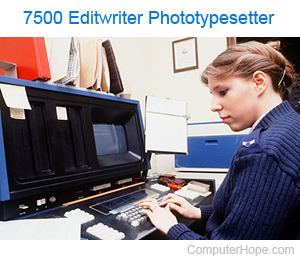Phototypesetter

A phototypesetter is a machine that was used to create printed text and graphics for various media, such as newspapers and magazines. Utilized in the field of graphic design and typography, phototypesetting has several advantages over traditional metal typesetting. They include greater flexibility in font styles and sizes, the ability to easily adjust text spacing and line length, and eliminating the need to cast metal type.
With the advent of digital technology and desktop publishing in the 1980s, phototypesetting use began to dwindle. Desktop computers and software allowed designers to create and manipulate text and graphics directly on a computer screen, which was more precise and efficient. As a result, phototypesetters were gradually replaced by computer-based typesetting systems, and the technology is now considered obsolete.
How did it work?
The initial phototypesetting machines operated by illuminating a font character using a film negative, then passing it through a lens to adjust its size on photosensitive paper or film. This resulting material was wound onto a spool in a light-proof container. Then, this medium underwent processing in a machine that guided it through several chemical baths (typically two or three), resulting in a product suitable for layout or film production.
In later iterations, phototypesetting devices adopted alternative techniques, like presenting a digitized character on a CRT (Cathode Ray Tube) screen.
Character, Desktop publishing, Graphic, Photolithography, Printer terms, Typewriter, Typography, Typography terms
